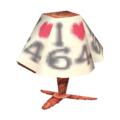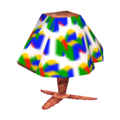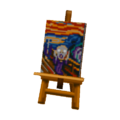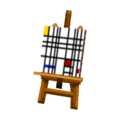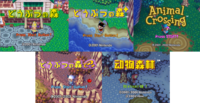Doubutsu no Mori+
| ||||||
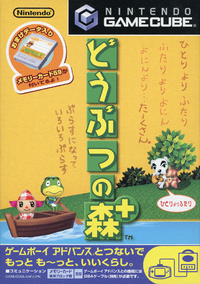 Game cover | ||||||
| Developer(s) | Nintendo EAD | |||||
|---|---|---|---|---|---|---|
| Publisher(s) | Nintendo | |||||
| Director(s) | Katsuya Eguchi Hisashi Nogami | |||||
| Platform(s) | Nintendo GameCube | |||||
| Release date(s) | ||||||
| Genre(s) | Simulation | |||||
| Language(s) | ||||||
| Modes | Single-player | |||||
| Media | GameCube Game Disc | |||||
| File size | 57 blocks (town save data) 3 blocks (travel data) 1 block (NES save data) | |||||
| Input methods |
Nintendo GameCube Controller Game Boy Advance (Animal Island only) e-Reader | |||||
Doubutsu no Mori+[nb 1] is an updated port and expansion of Doubutsu no Mori for the Nintendo GameCube. It released only in Japan on December 14, 2001, just eight months after the original title. This version contains extra features that had to be left out of the Nintendo 64 version, and also utilizes the GameCube's built-in clock to keep track of the date and time while dropping the Nintendo 64's original system that utilized an internal clock built into the game cartridge. Doubutsu no Mori+ cost 7,140 yen and sold 92,568 copies during its first week of sale in Japan.[citation needed]
Compared to Doubutsu no Mori, Doubutsu no Mori+ adds a significant amount of new content, including a museum for donating collectibles (of which there are also more of), a tailor where players can create custom designs, many new special events hosted by the town's mayor, and, with a Game Boy Advance connection, a tropical island where players can help a local islander furnish their house linked to a special minigame on the GBA. A series of cards for the e-Reader also released specifically for the game, featuring secret codes used to obtain items.[nb 2]
Due to featuring many Japanese cultural references, Doubutsu no Mori+ was extensively localized by Nintendo of America's Treehouse division, becoming Animal Crossing. Doubutsu no Mori+ and Animal Crossing are generally considered the same game by official Nintendo sources, but they have notable differences; many aspects of the game were altered or removed to make it more accessible to international audiences. Animal Crossing also added a significant amount of new content, such as new dialogue, items, and holidays. Nintendo's main Japanese branch was so impressed with the localization of Animal Crossing that they used it as the basis for Doubutsu no Mori e+, which released in Japan on June 27th, 2003.
Gameplay[edit]
Differences from Doubutsu no Mori[edit]
New villagers[edit]
Islanders[edit]
New special characters[edit]
Tortimer
Town mayorMabel
Clerk at Able Sisters tailorSable
Seamstress at Able SistersKapp'n
Ferries the player to and from Animal IslandWisp
Provides new furniture, clears weeds, or paints roofDon Resetti
Sometimes appears upon resettingBlanca
Appears on the train between towns in search of a face
Altered character designs[edit]
- 30 existing villagers had their designs changed between Doubutsu no Mori and Doubutsu no Mori+. These changes were retained in all later games.
| Name | Doubutsu no Mori | Doubutsu no Mori+ |
|---|---|---|
| Amelia | 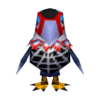 |
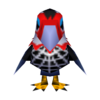
|
| Bangle | 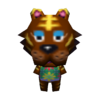 |

|
| Bluebear | 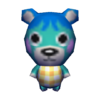 |
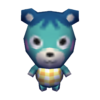
|
| Boris | 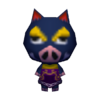 |
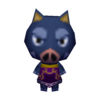
|
| Carmen | 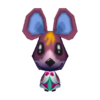 |
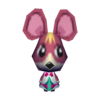
|
| Chevre | 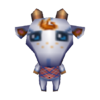 |
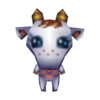
|
| Cleo | 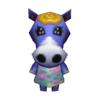 |
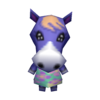
|
| Cupcake | 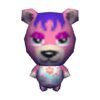 |
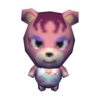
|
| Fang |  |

|
| Friga |  |

|
| Gwen |  |

|
| Huggy |  |

|
| Iggy |  |

|
| Kody |  |

|
| Lucy |  |

|
| Maple |  |

|
| Murphy |  |

|
| Nibbles |  |

|
| Pinky |  |

|
| Portia |  |

|
| Puck |  |

|
| Scoot |  |

|
| Spike |  |

|
| Static |  |

|
| Stella |  |

|
| Tiara |  |

|
| Ursala |  |

|
| Valise |  |

|
| Vladimir |  |

|
| Yuka |  |

|
Villagers with changed default clothing[edit]
Two villagers had their default clothing changed between Doubutsu no Mori and Doubutsu no Mori+.
| Name | Doubutsu no Mori | Doubutsu no Mori+ |
|---|---|---|
| Cube | 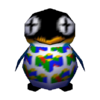 N cube shirt |
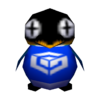 G logo shirt |
| Paolo | 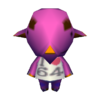 I love 64 shirt |
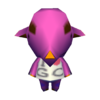 I love GC shirt |
Locations[edit]
- The Able Sisters shop is added and will be present on a beach acre, allowing for custom designs.
- The museum, along with Blathers is added. Fossils can still be sent to the Farway Museum for identification.
- The dock and Kapp'n appear on the beach
- Animal Island and all islanders are added.
- The house the player begins the game with contains an Orange Box and College Rule in addition to the Tape Deck, the only item there in Doubutsu no Mori.
- The player's house can now be expanded to have a basement and second floor.
- Tom Nook's store upgrades take only 1 day instead of 2.
Events[edit]
Tortimer appears at the town shrine for the new events based on Japanese holidays to give out special items. These include:
- Seven Herbs Day (Nanakusa-no-sekku) on January 7: Tortimer gives the Weed Model
- Adulthood Day (Coming of Age Day) on the second Monday of January: Tailor Model
- Bean-Throwing Day (Setsubun) on February 3: Bean-Throwing Set
- Hometown Day (National Foundation Day) on February 11: Tortimer gives 1 of 15 Station Models
- Girl's Day (Hinamatsuri) on March 3: Lovely Phone
- Spring Day (Vernal Equinox Day) (March 21-22): Market Model
- Fresh Green Day (Greenery Day) on April 29: Tree Model
- Garbage Day on May 3 (Constitution Memorial Day): Dump Model
- Tanabata on July 7: Tanabata Palm
- Summer Day (Marine Day) on July 20: Life Ring
- The Radio Exercises event from the Sports Fair was used for a new event, Morning Aerobics, from 6-7 AM on clear days from July 25 to August 31: Tortimer will give the player an Exercise Card for participating each day and an Aerobics Radio when completing it
- Mayor's Day on September 15 (Respect for the Aged Day): Shrine Model
- Autumn Day (Autumnal Equinox Day) on September 21-23: Katrina's Tent model
- Winter Day November 3 (Culture Day): Snowman model
- Labor Day (Labor Thanksgiving Day) on November 23: Shop Model
- Eve Eve December 23: Tortimer gives the Miniature Car to boys and the Dolly to girls.
Some holidays that were already present in Doubutsu no Mori also had gifts from Tortimer added:
- New Year's Day: Osechi
- Cherry Blossom Festival (April 5-7): Pink Tree Model
- Spring Sports Fair (March 20-21): Spring Championship Pennant
- Children's Day (May 5): Locomotive Model
- Summer Fishing Tourney (every Sunday in June): Bass Boat-Wrap Sushi
- Fireworks Festival (every Saturday in August): Three-Foot Ball
- Otsukimi, on the 15th day of the 8th lunar month (varies from September 8 to October 7 depending on the year): Tsukimi Dango
- The Night of the Thirteenth Moon (Jusan'ya no tsuki), a variant moon festival celebrated on the 13th day of the 9th lunar month (varying from October 6 to November 3): Moon
- Autumn Sports Fair (2nd Monday of October, Sports Day): Autumn Championship Pennant
- Halloween: Police Model
- Autumn Fishing Tourney (every Sunday in November): Big-Catch Flag
- New Year's Countdown: New Year's Eve Noodles
Other events/visitors[edit]
- Travelling to another town is done with GameCube memory cards, and the train ride between is seen, where either Rover or the newly added Blanca will appear.
- Gulliver gives the player unique world-themed furniture instead of a random furniture item.
- The player is now able to participate in the morning aerobics.
- Redd sells fans, pinwheels or balloons at the Fireworks Festival instead of Totakeke's songs.
Items[edit]
- Two shirts are unique to Doubutsu no Mori, having been redesigned in later releases:
- I Love 64 Shirt (redesigned as I Love GC Shirt — Worn by Paolo)
- N Cube Shirt (redesigned as G Logo Shirt in Doubutsu no Mori+ and Animal Crossing — Worn by Cube)
- Two paintings are exclusive to the N64 game: the Dreadful Painting and the Novel Painting, which are not obtainable in the normal course of play in later versions, likely due to the source artworks still being under copyright at the time.[nb 3] These items also exist in the code of the Japanese release of Animal Crossing and can be brought over from an N64 save file via Nintendo's now-discontinued Data Moving Service, but cannot be added to the catalog in the GameCube game. (In the international release of Animal Crossing and in Doubutsu no Mori e+, the items are removed entirely, with their index numbers instead pointing to duplicates of the DUMMY placeholder furniture.)
- Ten more NES games are added, and now have their game title as names instead of just being called "Famicom".
- Golden tools are added, and the standard Axe is now breakable.
- The "Items" section of the catalog now includes tools and other handheld items in addition to umbrellas.
- Some non-furniture items, such as tools, appear as sprites inside Tom Nook's store and the player's house. In all later games, they appear as 3D models when placed in interiors.
- Secret codes are added; they must be mailed to villagers to redeem them.
Bugs and fish[edit]
- When releasing a fish, the fish dives directly into the water like in all later games, instead of bouncing on the ground once.
- Insects can roam between acres, but not out to sea. This is reversed in Doubutsu no Mori+ and Animal Crossing.
- New fish can now be found in the sea, river, and holding pond: the Sea Bass, Red Snapper, Barred Knifejaw, Jellyfish, Arapaima, Crawfish, Frog, and Killifish.
- New insects are added: Pill Bug, Mole Cricket, Mosquito, Pondskater, Ant, Bagworm, Spider, and Snail.
- The Coelacanth appears from 4 PM to 9 AM instead of just 4 PM to 9 PM and 4 AM to 9 AM, and no longer can appear in snow, only rain.
Game Boy Advance connectivity[edit]
By connecting to a Game Boy Advance via a GameCube – Game Boy Advance link cable players can access the island, play NES games, and scan Animal Crossing-e cards with the e-Reader card to access special items, patterns, and mini-games. Certain NES games can be transferred to the Game Boy Advance to play on the go, and the island can be downloaded to a Game Boy Advance to play after returning to the player's town.
Other changes[edit]
- A white Nintendo logo is displayed upon starting the game instead of the Nintendo 64 cube logo.
- Three items can be kept in a storage unit as opposed to only one.
- All airchecks can be stored in a stereo instead of just one at a time.
- Stationery is sold in packs of four for
 160 Bells instead of individually for
160 Bells instead of individually for  60 Bells.
60 Bells. - The player can only hold a maximum of 50,000 Bells rather than 99,999.
- Multiple items can be selected when selling at Tom Nook's store.
- Most items dropped on the ground outside appear now have more specific sprites, such as the individual tools, instead of the few common ones from Doubutsu no Mori.
- The game now utilizes the GameCube controller's rumble feature.
Development[edit]
In a pre-E3 interview published in the July 2000 issue of Nintendo Power magazine, Shigeru Miyamoto mentions that he is working on launch titles for the Nintendo GameCube, stating: "One title is really a new genre of game—what we are calling a "communication" game, which we hope to finish this summer." That game, Doubutsu no Mori+, would be released a year and a half later in December 2001, two months after the launch of the GameCube in Japan, and eight months after Doubutsu no Mori. When questioned about upcoming Nintendo 64 games in a separate E3 2000 interview with IGN, Miyamoto states that he hopes to have "...a couple of new games for Nintendo 64 by the end of the year. These are not standard action-type games. We are calling them 'communication games'."[2] This would suggest that Doubutsu no Mori and Doubutsu no Mori+ may have been developed concurrently.
Despite being released near the end of the Nintendo 64's lifespan, Doubutsu no Mori sold through its entire print run. The success of the game, paired with the inability to produce enough cartridges to meet demand, encouraged the development team to port the game to the Nintendo GameCube with minor enhancements under the Japanese title Doubutsu no Mori+.[3] Taking advantage of the greater memory capacities of the GameCube, the team included new features that could not be added to the original game, such as Animal Island. The North American localization, Animal Crossing, was released eight months later.
Prerelease and unused content[edit]
Related media[edit]
Doubutsu no Mori+ received three tie-in manga: Doubutsu no Mori+ 4koma Gag Battle, Doubutsu no Mori+ 4coma Manga Kingdom, and Doubutsu no Mori+: Purin-Mura Nikki.
Gallery[edit]
Names in other languages[edit]
| どうぶつの森+ Doubutsu no Mori Purasu |
Animal Forest+ |
Notes[edit]
- ↑ Japanese: どうぶつの森+ Hepburn: Doubutsu no Mori Purasu, Animal Forest+
- ↑ The connection between the e-Reader and the GameCube was not introduced until Animal Crossing due to the technical capabilities of Japan's first e-Reader.
- ↑ The Scream and Composition with Red, Yellow and Blue, the respective basis for the Dreadful and Novel Paintings, would eventually enter the public domain in 2015 alongside the rest of Edvard Munch and Piet Mondrian's portfolios.
References[edit]
- ↑ Nintendo. "Animal Forest+". (Japanese)
- ↑ IGN (June 5, 2000). "Interview: Miyamoto and Aonuma". ign64.ign.com. Archived from the original on August 21, 2001. Retrieved May 1, 2021.
- ↑ Wired Staff (April 7, 2006). "Interview: The Wild World of Katsuya Eguchi". Wired. Retrieved November 8, 2020.
| First-generation Animal Crossing | ||||||||||
|---|---|---|---|---|---|---|---|---|---|---|
| ||||||||||
| Animal Crossing series | ||||||||||||||
|---|---|---|---|---|---|---|---|---|---|---|---|---|---|---|
| ||||||||||||||
























